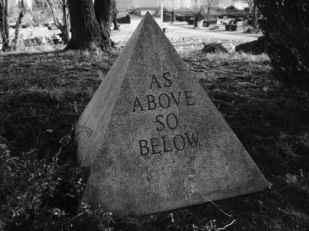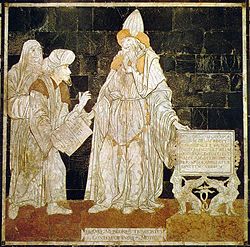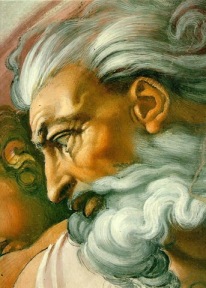
My chat with Janus and Domonic of The Magician and the Fool podcast has been published. We had fun talking about a wide range of Isis topics. You can listen here.
This week, I’m starting a 3-part series on an ancient text known as the Kore Kosmou. When this post was first published, it was in answer to a request and a question from a friend of this blog, Andrea, about this particular text…
But first, some background.
The Kore Kosmou is one of the Hermetic texts and it follows the common pattern of a dialog between teacher and student. In the Hermetica, most often the teacher is Hermes Trismegistos and the student Asclepios, Ammon, or “Tat,” the son of Hermes. In the Kore Kosmou, Isis is the teacher and Her son, Horus, is the student.
Certainly, there were many more Hermetica than what has come down to us. It also seems likely that there were once more Isis-as-teacher texts than just the Kore Kosmou and the few fragments we have. This, of course, would make a great deal of sense: Isis and Thoth-Hermes—Egypt’s two great and wise Magician Deities—serving as the main Hermetic teachers. It is interesting to note that, as time goes on, more and more scholars are recognizing the genuinely Egyptian elements that are such an important part of the Hermetica. More on that later.
But in case you’re not familiar with Hermeticism and the Hermetica, here’s a brief introduction and then we’ll delve into Andrea’s question about the Kore Kosmou and discuss what the text contains.
Hermeticism & the Hermetic Texts

Hermeticism began as a late Pagan branch of esotericism and was one of the many products of the meeting of the ancient Hellenic and Egyptian cultures in the centuries surrounding the beginning of the Common Era. The primordial and venerable religion of Egypt, its ancient wisdom, and its eternal magic combined with the dominant Greek culture, religion, and philosophy to produce a powerful mix that continues to influence esotericism to the present day.
Hermeticism’s most fertile home was the great syncretic Egyptian capital city of Alexandria—a city that had honored Isis from its inception and which left an indelible stamp upon the Hermetic tradition. As religious wisdom and philosophy flowed into Alexandria from many cultures, it likewise flowed into Hermeticism. In addition to Egyptian and Greek Paganism, Judaism, Christianity, Gnosticism, and Iranian Zoroastrian all added to the Hermetic amalgamation.

The Hermetic texts address a wide range of topics, including cosmic principles, the nature and orders of Being and beings, the human desire to know the Divine, astrology, alchemy, magic, and medicine, among others.
Scholars generally place the individual texts of the Hermetica in one of two camps: the philosophical and religious Hermetica, or the technical—that is, magical or theurgic—Hermetica. The main philosophical Hermetic texts that have come down to us are contained in the Corpus Hermeticum, a collection of approximately 17 treatises written in Latin and Greek. The exact date for the composition of the texts is unknown, but they are usually thought to be dated to the second or third centuries CE. Technical Hermetica range more broadly, and are tentatively dated to a period spanning the first century CE to the fourth. It is quite possible, however, that at least some of the texts were based on significantly earlier models.
We’re not sure when the Kore Kosmou was written either. In 1909, Egyptologist Flinders Petrie suggested that it could be as old as 510 BCE and thus is the oldest of the Hermetic texts. Frankly, it doesn’t feel quite that old to me and although it can be considered one of the most “Egyptian” of the Hermetica, it has enough in common with the other texts that the 1st-3rd centuries CE date seems more right to me.
So What Was the Question?

Andrea wanted to know what I thought about the androcentricity of the creation story told in Kore Kosmou. And it definitely is androcentric. The Supreme Creator is a He and a Father. “Nature,” the product of Creation, is a beautiful feminine Being. So there ya go; stereotypes all around.
But there’s absolutely nothing special about that. It’s just the usual sexism of the day.
As a woman reading the ancient esoteric texts, I almost always have to mentally “translate” or interpret them for myself. Is the author talking about human men or humankind? Are women intended to be included in this, that, or the other statement? Were women even worth bothering about in the author’s eyes? If there is an encounter with a feminine Divine Being in the text, does the same spiritual dynamic apply to women or would a woman have an encounter with a masculine Divine Being?
This is true of…well…just about every ancient text I’ve ever read, no matter the tradition. Not only must I puzzle through the meaning of the ancient author, but then I must try to discover whether or not it was intended to relate to me as a female seeker. (And all of this applies to heterosexuals; how much more translation is required if you’re LBGTQ?) So I grit my teeth and try to ignore the sexism to find the underlying spiritual meaning. Some days are better than others but, I must admit, it does get tiresome.
Okay, I’m done now. With that small rant duly ranted, let’s discover what’s in the Kore Kosmou.
As it is my opinion that the Ultimate Divine is ultimately beyond gender, as I summarize the text, I shall be using the term “Creator” and “Sole Ruler” (both of which are in the original text) instead of Father, Craftsman, God, or the masculine pronoun when referring to the Ultimate Divine. All other Deities retain Their traditional, textural pronouns.
What’s in the Kore Kosmou?
Give heed, my son Horus, for you shall hear secret doctrine, of which our forefather Kamephis was the first teacher. It so befell that Hermes heard this teaching from Kamephis, the eldest of our race. I heard it from Hermes, the writer of records, at the time when he initiated me in the Black Rites [possibly alchemy], and you shall hear it now from me…
—Kore Kosmou, Walter Scott translation

This is how Isis begins Her dialog. She then describes for Her son the creation of the Universe, the Elements, and Nature. Nature is the most important female character in the story and is described as “a being in woman’s form, right lovely, at the sight of whom the gods were smitten with amazement.”
Isis next describes how the Souls—which are Divine and share with the Creator the ability to create—were made and how they became too proud of their creative ability, overstepping the bounds the Creator decreed for them.
To punish the Souls for their pride, the Souls are placed into human bodies by Hermes Trismegistos on command of the Sole Ruler. Yet the Creator is merciful. As consolation to the imprisoned Souls, the Creator allows them to forget their heavenly origins, to receive blessings from the Deities, and to return to the Heavens provided they do good upon earth.

Nevertheless, once the Souls are embodied, they began to fight amongst themselves, killing each other and polluting the world, so much so that the Elements complain to the Creator. The Creator bids the Elements to return to Their work, for help is on the way.
And so the Creator sends Isis and Osiris, Who are “the efflux” of the Divine, to help create order, religion, and civilization.
The Goddess and God bring “that which is Divine” into human life, thereby putting a stop to savage slaughter. They establish the rites of worship on earth, consecrate temples, and give human beings food and shelter. They introduce the oath and law and justice. They teach the art of mummification. They discover the cause of death by finding that the life-breath eventually returns to its place of origin. They learn the ways of the Spirits and inscribe the secrets on stones for human edification. They devise the “magic of the prophet-priests” so that human souls can be nurtured by philosophy and human bodies can be healed by the healing art.
Having brought all these Divine blessings to earth, Isis and Osiris are allowed to return to heaven after speaking a hymn. Horus asks to learn the hymn…and that is, unfortunately, where the text breaks off.

Another fragment seems to pick up the tale and has Isis answering Horus’ questions about the nature of the many types of Souls, how they are differentiated, and how they become intelligent.
In the surviving Hermetica, Isis often concerns Herself with Souls; an interest continuing from Her early function as a funerary Goddess and a guide and protector of the dead. In other Isis-to-Horus fragments, Isis teaches about reincarnation and the nature of Souls. In their Isian and Hermetic concern with the journey of the Soul after death, the texts resonate with the power of the ancient Egyptian tradition from which they, in part, derive.
Read It for Yourself
If you’d like to read the whole text for yourself, you can find the G.R.S. Mead translation here. And the Kingsford-Maitland translation here. Both of these translations are in the public domain, which is why you find them online. Mead’s is overly poetic in true Victorian fashion and Kingsford & Maitland had their own agenda. Of the translations I know of, the Walter Scott version seems best to me, though he is criticized for some of the “corrections” he made. It, however, is not in the public domain, so you won’t find it online. Always remember; translation is an art, not a science.
But it seems that I’m not quite done with the Kore Kosmou. So next time, we’ll talk about some of the genuinely Egyptian elements in the text and find out how it may indeed be the most “Egyptian” of the Hermetica.



